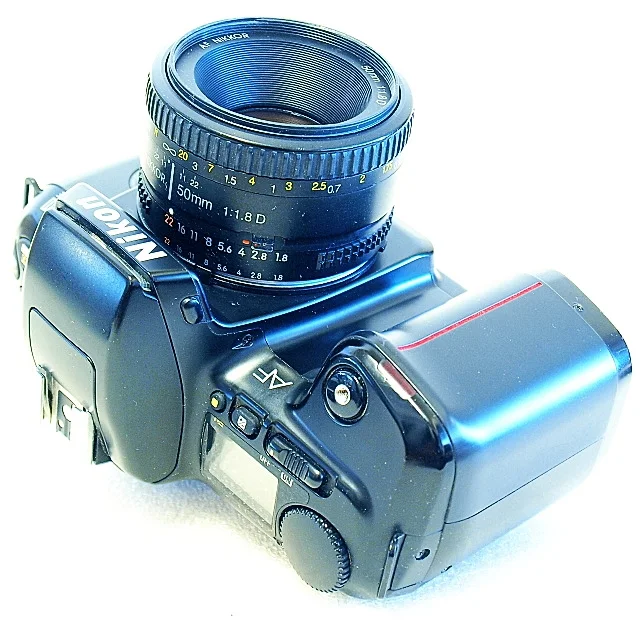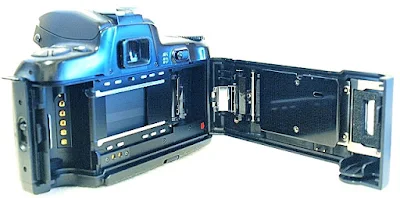Looking through the list of tough-bodied Nikon AF SLR cameras that I have already done quick reviews of, which includes the professional Nikon F4 (1988), the high-end Nikon F-801 (1988), and the later Nikon F90X (1994), I will continue next with another quick look review of the mid-range Nikon F-601 or the N6006 in the US.
The Nikon F-601, designated as a high-end mid-range model, is positioned between the entry-level F-401 and the advanced high-end F-801.
The camera was the only Nikon SLR model introduced in 1990, the first Nikon to use a 6V Lithium battery pack, and the second to be fitted with the improved autofocus and spot metering system, which is the mainstay of the F-801s.
The F-601 was also the predecessor to the F70 (N70) and F75 (N75) series, the next build from Nikon that comes with a lighter body weight and plenty of plastic, which, to me, tends to lose out on the robustness of the former models. The new series includes the Nikon F100, Nikon F80, and the lower-end F50 (N50) and F65 (N65).
Introduction to the Nikon N6006 (F601) -- Video 1 of 2
In 1990, Nikon began manufacturing the N6006 (F610) for its 1991 release. Sold until 1994, the N6006 represented a mid-level camera with substantial capabilities, advanced features, and high-level usability. Compatible with Nikon's AI-S and AI lenses, the N6006 provided users with a substantial set of high-grade glass to choose from.
You may also come across a version of the camera designated as the Nikon F-601M, a simplified version of the F-601. This model has no autofocus capability, no spot metering, and no built-in flash.
A Clear Advantage
A clear advantage of using this camera series as your film body, if you are already a Nikon DSLR user, is that they will take on all Nikon F lenses you already own. All AF Nikkor lenses, except for F3AF lenses, can be used on the F-601, as are all Ai and AI-S lenses, with which you can't do Autofocusing, Program Auto, Shutter Priority Auto shooting modes, and Matrix Metering.
Older Nikon manual focus lenses can be used on the F-801s just as easily. Focusing can be done with the aid of the Electronic Rangefinder or by utilizing the clear matte field of the BriteView viewfinder screen.
These robust Nikon AF SLRs are the nearest you can get to the Nikon DSLRs' functions and functionalities that you are currently using. Aside from a slightly slower AF and the need to rewind and reload the camera with a new roll of film when the one currently has all been exposed, there is really not much difference in the handling of the two genres of cameras, sans the chimping that you can do on the DSLR.
Design and Build
The Nikon F-601 comes with an electromagnetically controlled focal-plane shutter with speeds from 30 seconds to 1/2000 second and battery-powered B mode. Flash sync is at a maximum of 1/125 sec. The self-timer is electronic and can be set in 1-second increments from 2 to 30 seconds, and a two-shot mode with a 5-second delay between the first and second.
The camera features three metering systems: matrix metering, center-weighted, and spot metering. The meter has a range of 0 to 19 EV at (ASA 100, f/1.4), settable to film speeds from 25 to 5000 ISO for DX encoded film, but can also be manually set from 6 to 6400 ISO.
Exposure control is an extensive array that includes Auto Multi-Program, Normal Program, Aperture Priority, Shutter Priority, and Manual Exposure modes, AF-Lock, AE-Lock features, and Exposure Compensation in 1/3 increments.
The F-601 is also fitted with a button-release built-in TTL flash with a GN of 13, usable in auto and fill-flash modes. Film transport is motorized, autoloading to film frame 1, and can be set to advance the film in S (Single), CH (Continuous High, 2fps), or CL (Continuous Low, 1.2fps) modes. The F-601 Quartz Date has a data back option.
Basic Camera Features
Quite prominent on the left front of the Nikon F-601 built form is the fairly substantial battery chamber/handgrip hump which houses the solitary shutter release button on its slanting top. To the right of the housing for the lens mount are the only other functional features of the F-601: the lens release lock and the Focus Mode Selector lever switch.
The F-601 is one of the models, another one being the F80, that has a cable release socket integrated with the shutter release button, ala most older models of mechanical SLRs. We do not see this on the F4, F-801, or F90X.
The top plane of the F-601 is where all the main controls of the camera are located. On the extreme left are the controls for the main camera functions, a set of four buttons clover-leaf style with two smaller pushbuttons next to it. Each of the buttons works with the thumbwheel (on the extreme right of the top plane) to enable the major functions of the camera to be adjusted.
For example, the ISO button is used to set the film ISO when it is held and the thumbwheel is rotated, or is used to toggle between DX coding and Manual setting if it is pressed when the shift button is pressed. The MODE button sets the selection for the PASM modes, and the DRIVE button controls the shooting mode of the camera (Single, Continuous High (2fps), or Continuous Low (1.2fps)). The BKT button is used to set Auto Exposure Bracketing.
Of the two small buttons, the top is for the selection of the Metering System and for setting the Slow Sync function, while the lower button sets the Self-Timer and Rear Curtain Sync. On top of the pentaprism hump of the F-601 are the button release, built-in flash, and also the camera's hot shoe.
To the right of the top panel, above the LCD panel, are the SHIFT button, the Exposure Compensation button, and the Power On/Off switch. The SHIFT button is used to set the alternative functions shown in matte gold at various locations on the camera body. Pressing the SHIFT and DRIVE buttons together, for example, will set the camera mode to AF-L (Auto Focus Lock), and off when the combination is selected again.
All modes of the major functions of the camera are displayed on the LCD panel.
On the back of the camera, the AE-L/AF-L lever is just where the thumb rests when you are holding the camera up to your eye, the QD panel is right in the middle of the film back, Film ID window towards the edge of the body, and just under the pentaprism hump, one of the largest and brightest fixed eye-level viewfinder you have ever seen.
On the bottom plane, the tripod socket, battery chamber cover, and a two-handed film rewind setup - a finger from one hand to push a slider motor switch in the direction of the arrow shown, and another finger from the other hand to press down on the silver film release button to get the system going.
The film box is a quick autoload system that is almost standard throughout the industry and is very easy and convenient to use. All you have to do is drop the film canister into the chamber provided, pull the film tab tight, and even across the film frame opening till the red indicator, close the film back, and the auto film forward system will take over.
Viewfinder Readout
The viewfinder readout is a simple BrightView screen etched with indicators for the 5mm and 12mm diameter Reference Circle, and a rectangular Focus Bracket. An LED display along the bottom of the screen lights includes the Focus Indicators, Exposure Mode, Film Speed/Shutter Speed setting, Aperture/Exposure Compensation Value, Electronic Analog Display, Exposure Compensation, and flash-ready light.
Battery
While the Nikon F4 and F90X are powered by AA batteries, which are available as everyday user items in retail shops and supermarkets, the Nikon F-601, on the other hand, uses a PG-2P Lithium battery pack to power its functions, and the Quartz Date version requires an additional CR2025 button cell to operate.
The F-601 is the first Nikon AF SLR model to be powered by a Lithium battery, a practice followed by subsequent Nikon AF SLR models.
Battery life, as indicated in the instruction manual, is dependent on the shooting modes, weather conditions, and the lens you are using. This may range from as low as 3 rolls when the camera is used with full flash at -10 degrees Centigrade (14-degree Farenheight), to up to 75 rolls of 36-exposure film when used without flash in 20-degree Centigrade weather.
Camera Body Weight
The F-601 Quartz Date weighs in at a comfortable 660 grams without the battery pack.
Side by Side with the Nikon F4, F801s, and F90X
Pitted side by side with the Nikon F4, Nikon F-801s, and Nikon F90X, the F-601 does have its own way of appealing to you, using its advanced autofocus feature and the excellent, five-segment matrix reading, center-weighted or spot reading metering system inherited from the F-801 launched two years earlier.
Built form-wise, the mid-range F-601 is on par with the rest of the series, with a body that is solid and extremely well made, and just the right ergonomics for extended use. The large and bright viewfinder is an added advantage, while its functions and functionalities were already the most advanced.
As an option for the beginner film enthusiast, or for digital photographers who have the inkling to go into film photography, the F-601 is highly recommended as a choice of a truly capable camera with substantial capabilities, advanced features, high-level usability, and best of all, a very low investment, something I wouldn't want to miss every time I see one on auction listings.






















No comments:
Post a Comment